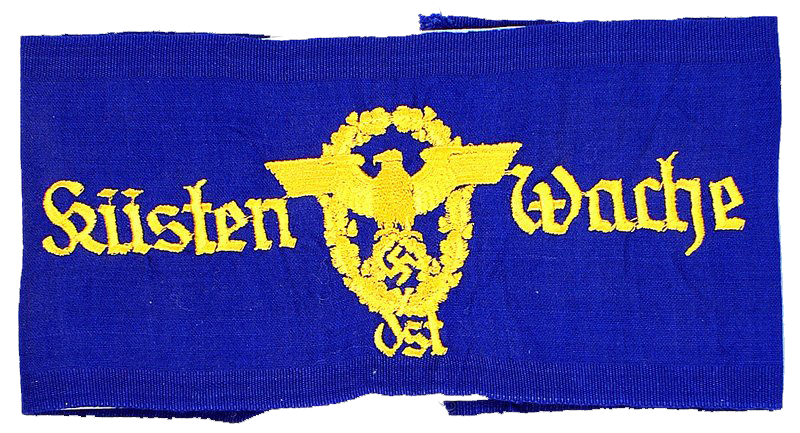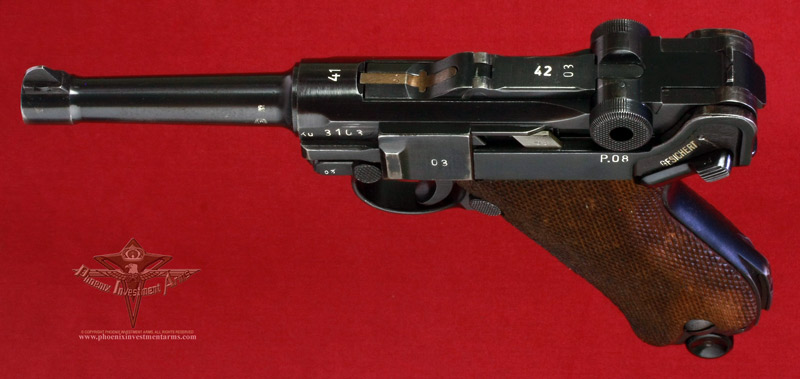
|
|
There are as many theories about the Mauser Kü as there are people that study them. What we do know is that the parts were made by Mauser and they have been Krieghoff/Luftwaffe proofed. This is an outstanding example of the Kü variation. At the start of 1941 dates were changed to two digits and the P.08 markings were begun. In February 1941 the 42 Code was changed to "byf" so production of pistols and rifles by Mauser are so marked. It is known that during 1941 the Luftwaffe procured 36,000 Parabellums' but how many were Kü marked is not recorded specifically but it is estimated that 5,000 is the number. (1924) |
|
|
|
NOTE: Photographs taken today with the high mega-pixel camera show more than we sometimes can see with the human eye. Magnified close-ups show us tool marks and natural surface conditions that one normally doesn't see in the ordinary handling of the weapon. Photographs are copyrighted, all rights reserved, any extraction, reproduction or display of gun pictures without the express consent of the Phoenix Investment Arms is strictly prohibited. Thank you for your cooperation. Please visit Legal (tabbed) for Conditions of Sale. |
 |
|
|
The 41 byf code Kü Mauser Parabellum is a hard-to-find Luger for the collector since it was only produced for few months under wartime production. The Kü variation, despite the multiple theories of origination is an example of the enigma of unknown production. Some say they are re-works and there is some evidence to suggest that from tool markings on some parts. Others say they were "parts guns" made in the midst of the war. If one accepts that "it is what it is" then you have a very limited variation for the collector to enjoy and your ticket to join the research and debate. |
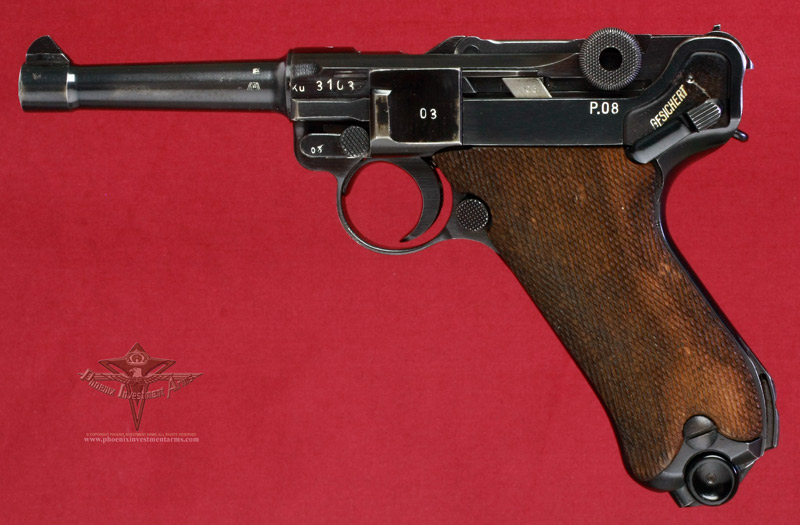
|
|
|
This Parabellum is 9mm, with a 4" (100mm) barrel, a dovetailed inverted front sight and a "V" notch rear sight on the rear toggle link. Serial number placement is in the military ("exposed") style. The first toggle link is marked wit the Mauser code "byf". The thumb safety is marked "Gesichert" and extractor "Geladen." There is a stock lug, the trigger, the locking lug and thumb safety are blued, as expected of the "byf" Mausers. |
|
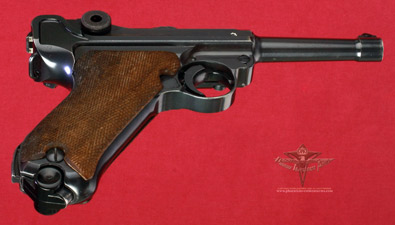
|
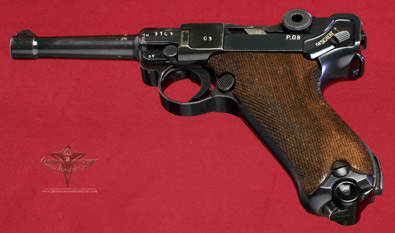
|
|
This Parabellum has a stock lug, is all blued (as post 1937 Lugers were with Mauser) and a hold open. Late in 1941 the Waffenamt inspector "E/655" was replaced by "E/135" and so began the new proofs. The barrel is proofed with the Eagle 655 proof giving us an indication that the barrels that were left over were shipped for the assembly of the Kü. |
|

|
|
|
Below is the Stage 2 Krieghoff proof on the right of the receiver and the left side of the barrel beside the breach block. In all previous Luger production the right side final proof is the acceptance proof which one may assume reflects who brought the Parabellum to final proofing. It doesn't appear this was a final assembly by Mauser. |
|
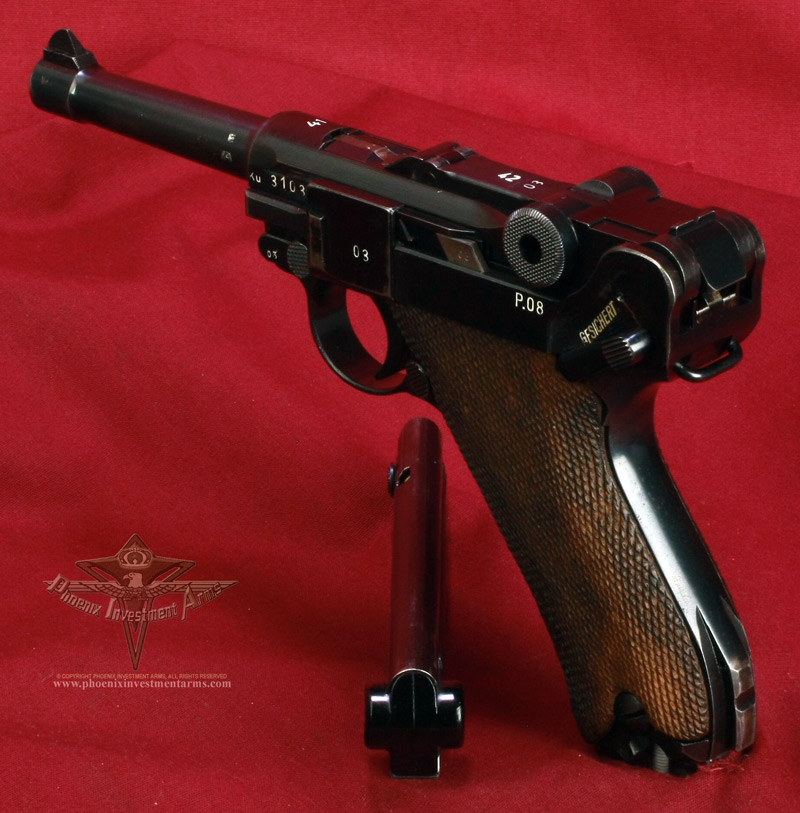 |
|
|
|
|
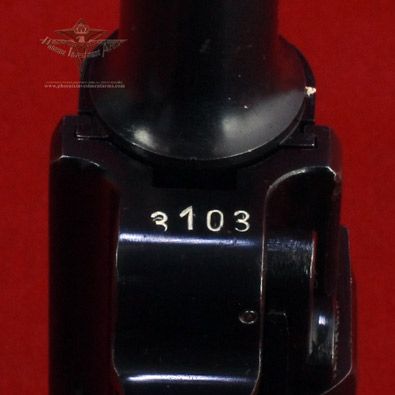
|
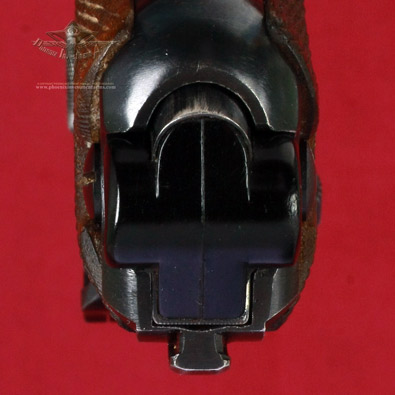
|
|
Under the barrel the frame is serial numbered in a different type than Mauser used nor is it the font used by Krieghoff. The numbers are larger than the Mauser font and the bottom of the barrel is not proofed but the top is the Eagle 655 indicating this part was supplied from "inventory" as the code changing had changed twice to "42" and then to "byf" before this barrel was applied to a '42'. The magazine is an code 122 which is a magazine used by Krieghoff. |
|
 |
|
|
The German Luftwaffe (Air Force): By the summer of 1939, the Luftwaffe had nine Jagdgeschwader (fighter wings) mostly equipped with the Messerschmitt Bf 109E, four 'Zerstörergeschwader (destroyer wings) equipped with the Messerschmitt Bf 110 heavy fighter, 11 Kampfgeschwader (bomber wings) equipped with mainly the Heinkel He 111 and the Dornier Do 17Z; and as it had encountered design difficulties, was just starting to accept the Junkers Ju 88A for service with only a dozen aircraft of the type considered combat-ready, and four Sturzkampfgeschwader (dive bomber wings) ready for combat, primarily armed with the iconic Junkers Ju 87B Stuka. The Luftwaffe 's strength at this time stood at 373,000 personnel (208,000 parachute troops, 107,000 in the Flak Corps and 58,000 in the Signals Corps). Aircraft strength was 4,201 operational aircraft; 1,191 bombers, 361 dive bombers, 788 fighters, 431 heavy fighters, and 488 transports. It was an impressive force. |
|
 |
 |
|
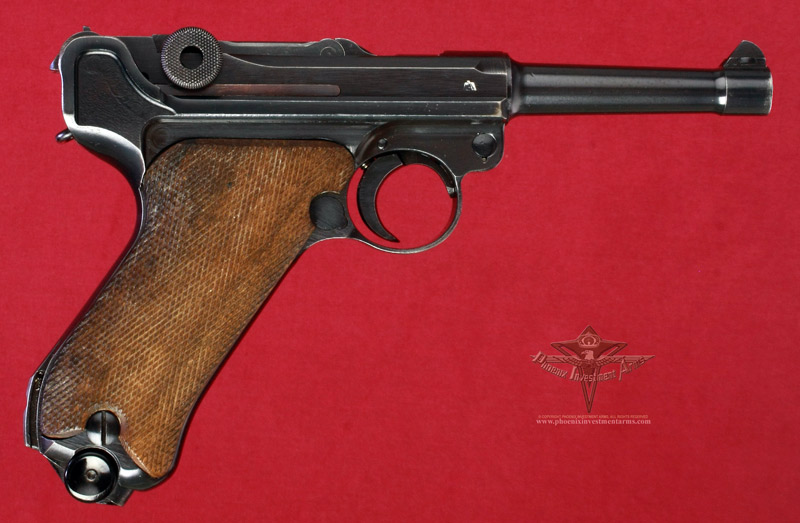
|
|
|
The right side of the gun has only one acceptance proof and that is the accepted Krieghoff Stage II proof markings. This very clean classic Luger with the end of war type III magazine, minimal acceptance proofs and the elusive Kü markings to make it one of the few variations that this long after the war collectors still discuss its origin. |
|
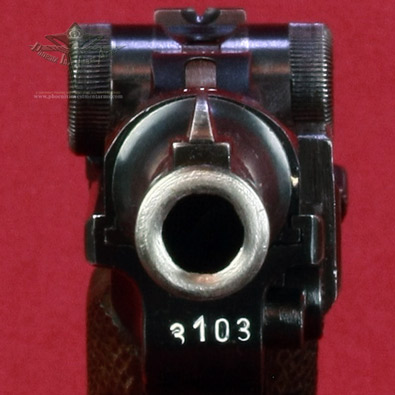
|
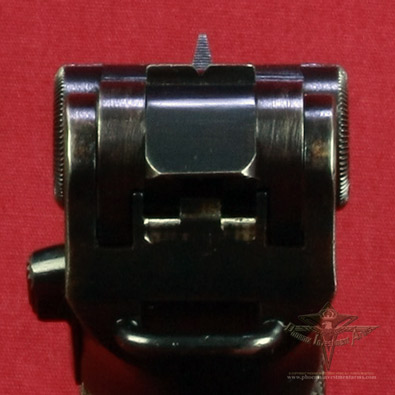
|
| Looking at the serial number and front sight we can see the gothic style type which was not used by Krieghoff and bigger than that by Mauser. These and other markings suggest the gun was assembled by a sub-plant of Krieghoff from HK and Mauser left over parts. The rear toggle link is missing the customary serial number, only found on the Kü Parabellum. | |
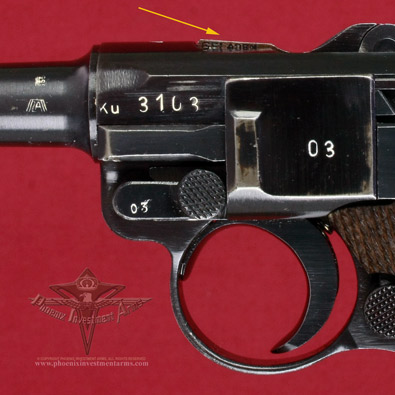
|
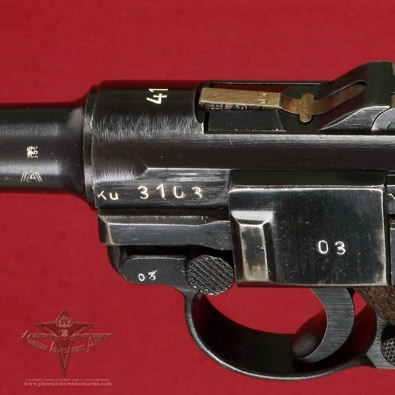
|
| Above Left: The late Krieghoff Stage II proof is visible on the barrel that is also marked with the E655. While conjecture it would appear that the barrel was manufactured by Mauser in 1939-40. The Krieghoff proof appears to be the final assembly plant for this variation, making in the least unusual. | |
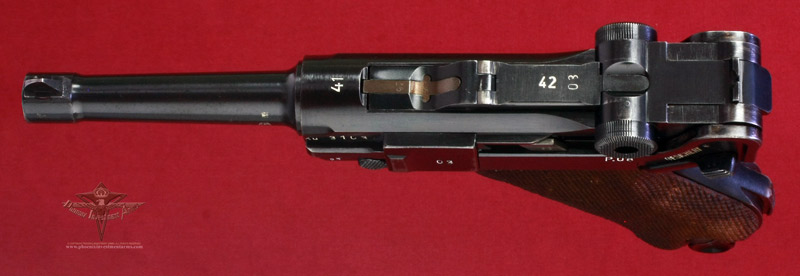
|
|
| The most distinctive feature of these pistols is undoubtedly the toggle-lock mechanism, which holds the breech closed by locking in a manner not unlike the human knee, which can sustain a heavy weight when straight, but once bent is quite easy to continue to bend. The toggle joint in its straight position resists the rearward force of the detonating cartridge, then "buckles" after enough time has passed. When a round is fired the entire breech, barrel and toggle move straight rearward (on rails) until the toggle begins to ride up on a pair of cams that "breaks" the toggle (makes it bend at the joint). Once the toggle joint is no longer straight, it bends freely, allowing the bolt to come rearward, and the striker to be cocked. The spent cartridge is extracted by a combination extractor/loaded chamber indicator on the top of the toggle; it is ejected as the toggle nears the end of its rearward free travel compressing the spring in the grip and returning the breach to battery. A new round is stripped from the magazine and chambered as the toggle is driven back to the straight position by the spring. | |
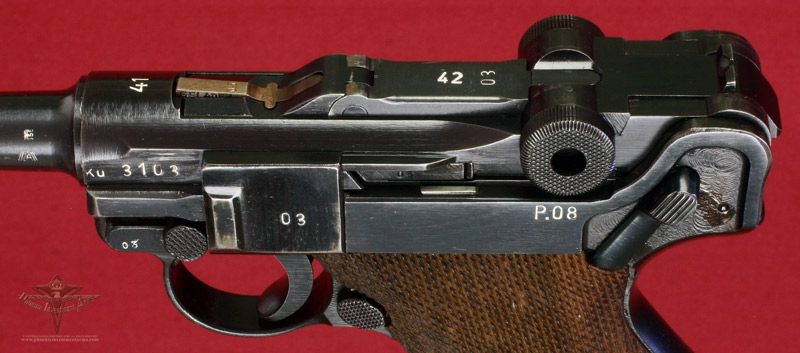
|
|
| The Extractor is marked GELADEN (Loaded) and is both visible and tactilely available to the shooter to tell them when the gun is loaded. This extraordinary feature was adopted in the 1906 model and continued until the end of production in 1945. This extractor, with the last two digits of the serial number, appears straw blued and the last time these parts were not blued was with the transition to the solid extractor in 1900. While sometimes small parts take on a different hue based on parts blued separately at varying heat of the bluing process this one appears clearly straw (heat process) and serial numbered. | |
|
|

|
|
|
Above: The close up of the top of the receiver reveals the deep salt blue finish and the high-lighted serial number on the 1st toggle link and thumb safety. There is no number either above or under the 2nd toggle link while it is proofed with an undistinguishable drooped wing eagle. |
|
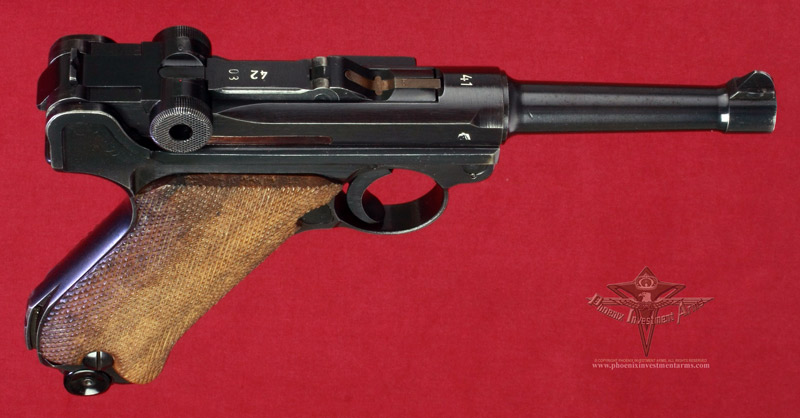
|
|
This is a good clean example of the Mauser KU. It shows a deep blue and displays minor and honest holster wear on the muzzle band and side rails. |
|
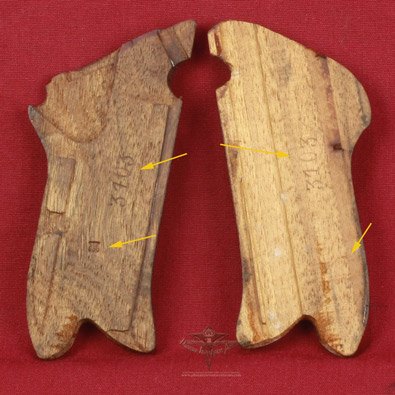
|
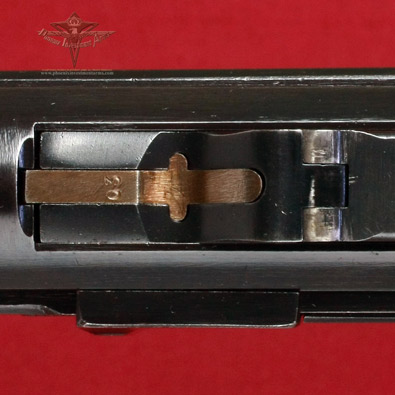
|
|
The grips match the gun and the numbering is in four digit matching numbers. There is also an Eagle 655 proof on the inside of the grips (most found on extra grips made for armorer's tool kits). The Breech Block has the straw blued extractor serial numbered in a serif number. |
|
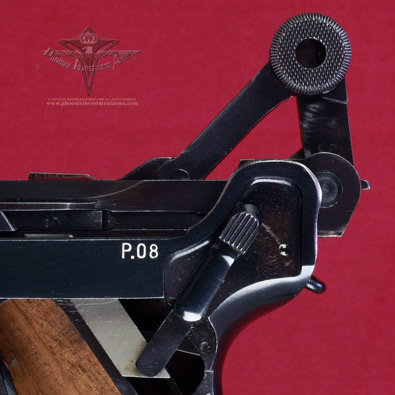
|
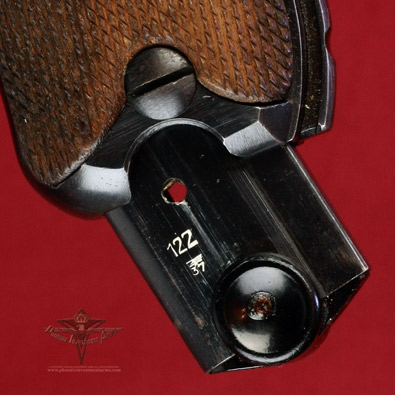
|
| Left: In 1932 the Reichswehrministerium issued an order that the rear connecting pin be serial numbered to the gun. This Parabellum is not numbered which coincides with the Krieghoff practice of not numbering the later pins and Mauser who followed the requirement and numbered their's. Just another indication the Luger was assembled by Krieghoff. Right: A 122 proofed Eagle 37 P.08 extruded magazine which were manufactured by Haenel and used in the 41-45 Krieghoff Parabellums. Another diclidotomy created by the interchanging of parts. | |
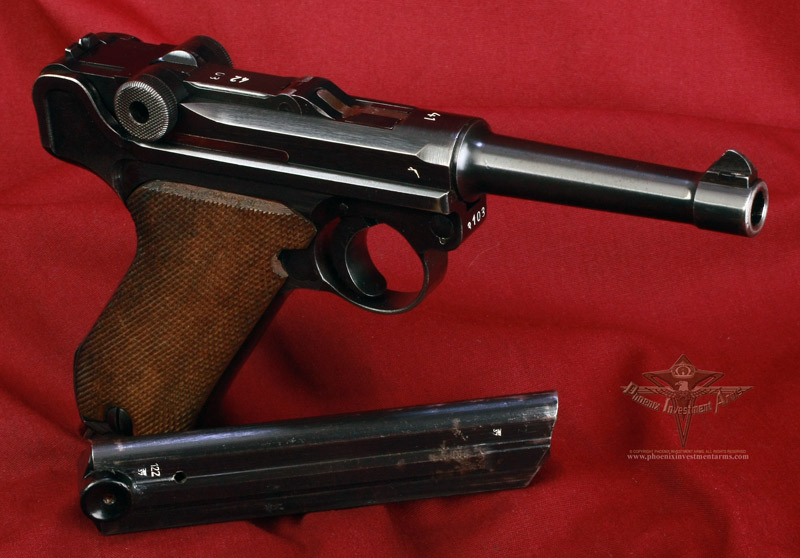
|
|

| |
|
One theory of the Mauser Kü is that they were a contract for the German Coastal Flying Service, ("Küstenfliegerstafflen"). The Krieghoff Luftwaffe proof that appears on the barrel, the left side of the breach block and the right side of the receiver clearly links these guns to the Luftwaffe. Another theory: Some say the Kü means Krieghoff Ulbricht which equals rework and re-issue. Some contend they were built from left over parts but of the Kü's I have examined over the years, each one was proofed, serial numbers matched from the firing pin to the grips and finishes were finely done consistent with the regular production Parabellum. |

|
|
|
The grips are in very good condition. There is a Waffenamt Eagle 655 stamped on the grips indicating that it was inspected by a Mauser inspector. This dichotomy is acerbated by absence of 1st and Heer acceptance stamps. This rare Kü Luger has been cared for over 74 years now. It is looking for a good home. |
|
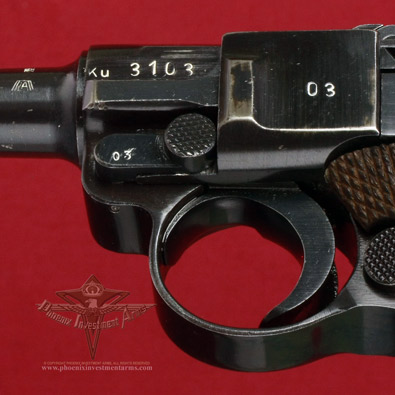
|
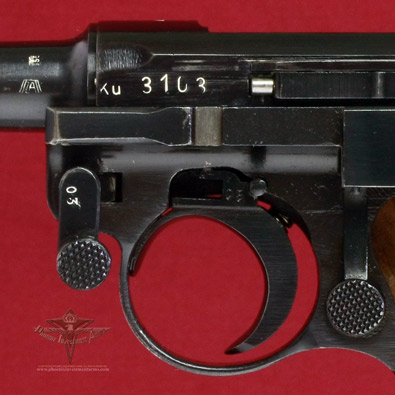
|
Detail pictures of this Kü showing the S/42 under the barrel and the Kü in front of the serial number. In the past 40 years we have seen the Kü in front of the number and behind it. The trigger is revealed (Above Right) to show the '03' replication of the serial number. |
|
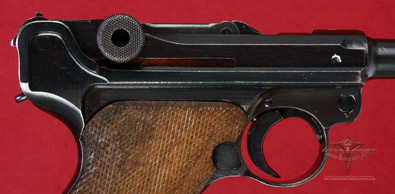
|

|
|
This Luger has been cared for over the years and shows well both inside and out. The barrel is strong with distinctive lands and grooves. Inside the firing pin is the original and matches the guns serial number. |
|
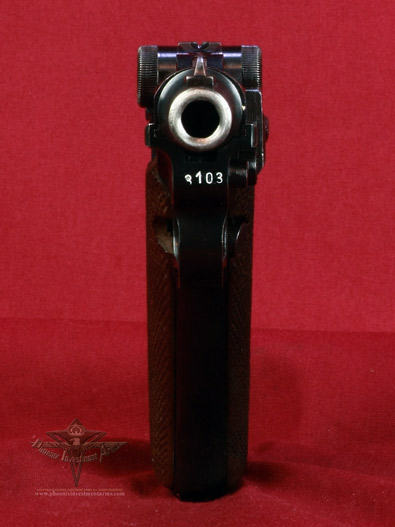
|
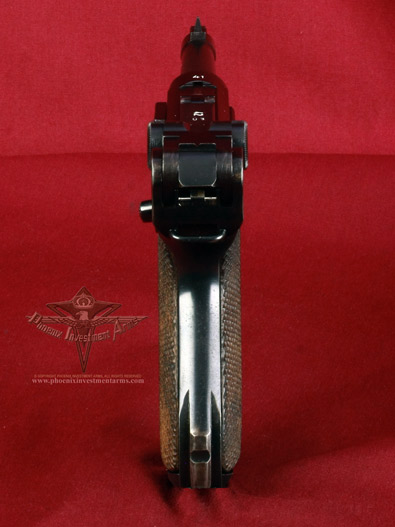
|
|
It is entirely subjective to give any Luger a rating of excellent or fine, just as it is to declare it xx% blued or strawed. Few Lugers are out of the box new and these are premium priced. Bluing percentages is like Beauty, in the eye of the beholder. We strive to provide pictures so you can judge for yourself if the gun meets your criteria. |
|
 |
|
|
German '88's' employed by the Luftwaffe as part of the air defense system over Germany during the war. The Luftwaffe (German Air Force) controlled the air defenses and coastal anti-aircraft artillery in the ground role in conjunction to the aircraft interceptors. |
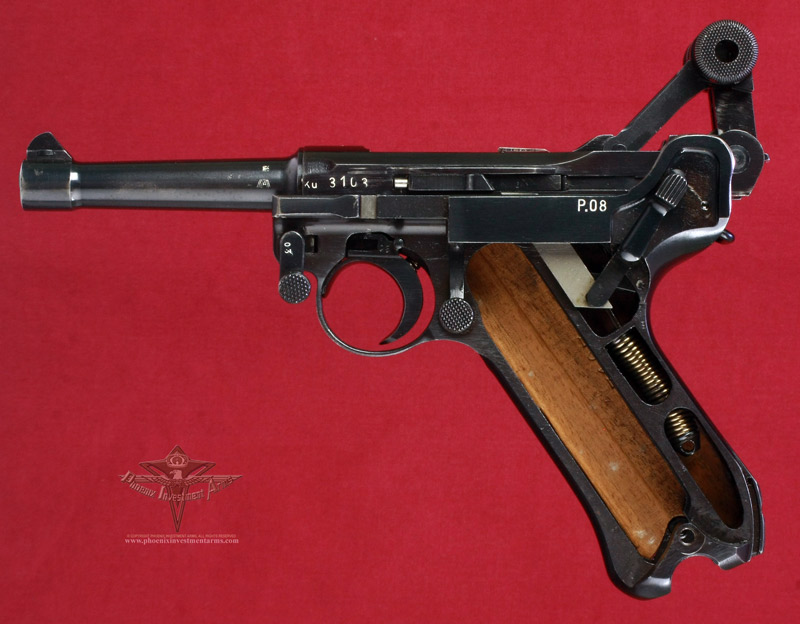
|
|
|
The inside of this Kü appears very clean. Note in full recoil the small 2mm "hump" at the rear of the frame to protect the rear main axel pin was a Mauser innovation. So one can assume this began the rework as a Mauser frame and parts were accumulated outside the standard Mauser production to produce this rare variation. |
|
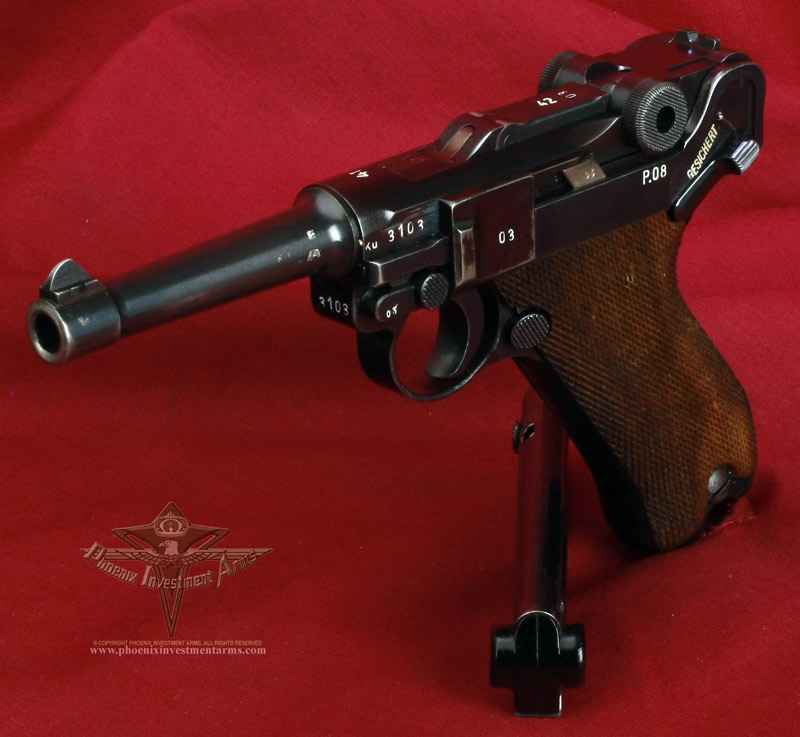
|
|
This Luger dresses out nicely with the deep and crisp proofs. The white that appears on the proofs and number is something that we apply to make all the proofs easier to see. On the orginal Parabellums only the Gesichert (Safe) appeared in white.
The grips are in especially fine condition. |
|
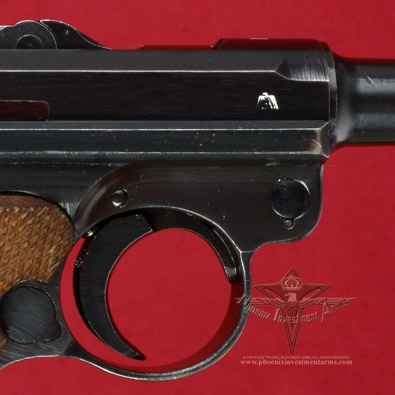
|
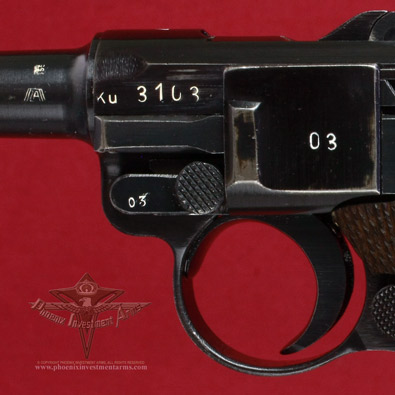
|
Above Left is the Stage 2 Krieghoff proof on
the right of the receiver and the left side of the barrel (above right) beside the
breach block. In all previous Luger production the right side final
proof is the acceptance proof which one may assume reflects who
brought the Parabellum to final proofing. |
|

|
|
|
Picking up this Luger you would
assume it is a standard Mauser (19)41 42 code. The last two
digits of the serial number appear on the extractor, 1st toggle link
and on the top of the thumb safety. Only on closer examination
one begins to see the differences and the extraordinary version of
the Parabellum this represents. |
|
Another theory that has been advanced since the popularity of the 1990's German TV show about their Coast Guard "Küstenwache". It has been advanced that Field Marshal Erwin Romel created ant-aircraft and coastal defences that fell under the air force (Luftwaffe) and generated the requirement for side arms for these "88's" that they used. There is a known unit of the German (Nazi Era) police that used a blue armband with the Kü.
70 Years after the end of WWII there are many things that we are still discovering and one of them is the basis of the Kü Parabellum. |
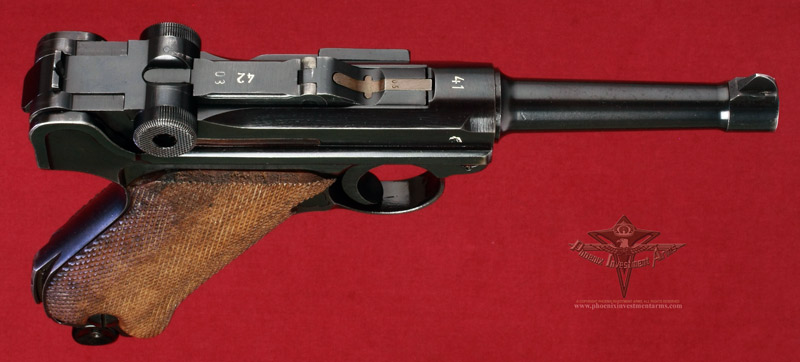
|
|
This is a excellent example of the "42" Mauser Kü Luger with Luftwaffe proofs. A much sought after variation attributed to the Luftwaffe in some form of their military or para-military organization in minty grade, and a hard to find (41/42) variation for the Kü or Luftwaffe collector. Any questions or requests for addition pictures to josef@phoenixinvestmentarms.com This Kü is offered for $4,495.00 over-the-counter. We reserve the right to withdraw this gun from the web and auctions when sold over the counter; call for availability. |
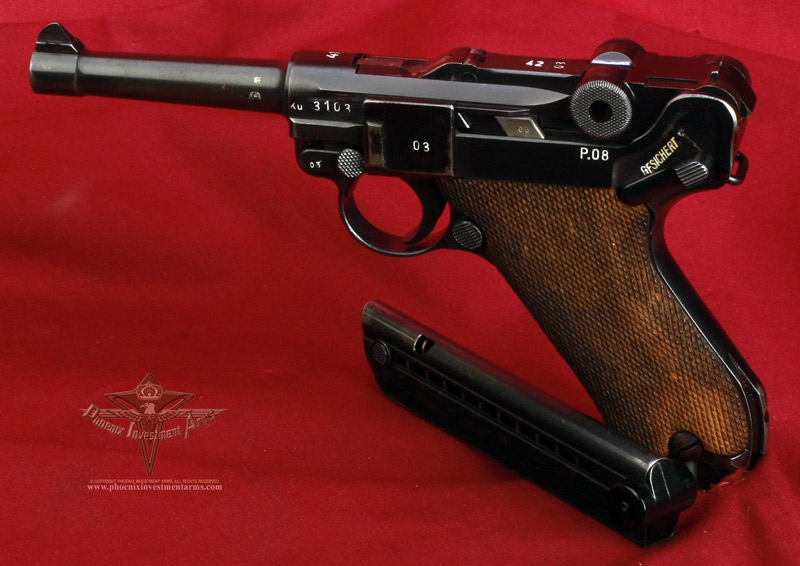
|

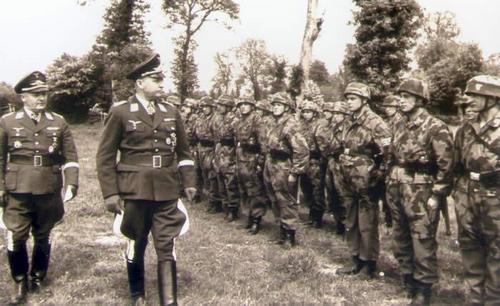 General
Student reviewing Paratroopers. Kurt Student (12 May 1890 – 1 July 1978) was a German Luftwaffe general who
fought as a fighter pilot during the First World War and as the
commander of German Fallschirmjäger (paratroops) during the
WWII. He received the Knight's Cross of the Iron Cross with Oak Leaves (Ritterkreuz
des Eisernen Kreuzes mit Eichenlaub). The Knight's Cross of
the Iron Cross and its higher grade Oak Leaves were awarded to recognize
extreme battlefield bravery or successful military leadership.
General
Student reviewing Paratroopers. Kurt Student (12 May 1890 – 1 July 1978) was a German Luftwaffe general who
fought as a fighter pilot during the First World War and as the
commander of German Fallschirmjäger (paratroops) during the
WWII. He received the Knight's Cross of the Iron Cross with Oak Leaves (Ritterkreuz
des Eisernen Kreuzes mit Eichenlaub). The Knight's Cross of
the Iron Cross and its higher grade Oak Leaves were awarded to recognize
extreme battlefield bravery or successful military leadership. 